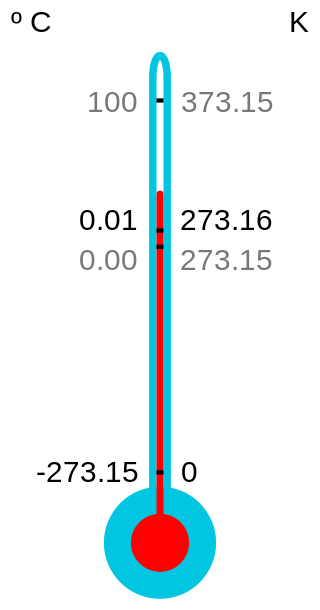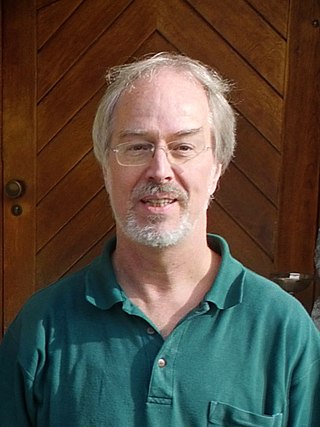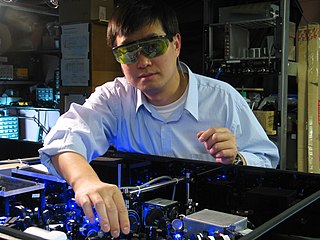Related Research Articles

Absolute zero is the lowest limit of the thermodynamic temperature scale; a state at which the enthalpy and entropy of a cooled ideal gas reach their minimum value, taken as zero kelvin. The fundamental particles of nature have minimum vibrational motion, retaining only quantum mechanical, zero-point energy-induced particle motion. The theoretical temperature is determined by extrapolating the ideal gas law; by international agreement, absolute zero is taken as −273.15 degrees on the Celsius scale, which equals −459.67 degrees on the Fahrenheit scale. The corresponding Kelvin and Rankine temperature scales set their zero points at absolute zero by definition.

A fermionic condensate is a superfluid phase formed by fermionic particles at low temperatures. It is closely related to the Bose–Einstein condensate, a superfluid phase formed by bosonic atoms under similar conditions. The earliest recognized fermionic condensate described the state of electrons in a superconductor; the physics of other examples including recent work with fermionic atoms is analogous. The first atomic fermionic condensate was created by a team led by Deborah S. Jin using potassium-40 atoms at the University of Colorado Boulder in 2003.

Deborah Shiu-lan Jin was an American physicist and fellow with the National Institute of Standards and Technology (NIST); Professor Adjunct, Department of Physics at the University of Colorado; and a fellow of the JILA, a NIST joint laboratory with the University of Colorado.

The Max Planck Institute for Gravitational Physics is a Max Planck Institute whose research is aimed at investigating Einstein's theory of relativity and beyond: Mathematics, quantum gravity, astrophysical relativity, and gravitational-wave astronomy. The institute was founded in 1995 and is located in the Potsdam Science Park in Golm, Potsdam and in Hannover where it closely collaborates with the Leibniz University Hannover. Both the Potsdam and the Hannover parts of the institute are organized in three research departments and host a number of independent research groups.

Rudolf Grimm is an experimental physicist from Austria. His work centres on ultracold atoms and quantum gases. He was the first scientist worldwide who, with his team, succeeded in realizing a Bose–Einstein condensation of molecules.

The Gottfried Wilhelm Leibniz Prize, or Leibniz Prize, is awarded by the German Research Foundation to "exceptional scientists and academics for their outstanding achievements in the field of research". Since 1986, up to ten prizes have been awarded annually to individuals or research groups working at a research institution in Germany or at a German research institution abroad. It is considered the most important research award in Germany.

Gerhard Rempe is a German physicist, Director at the Max Planck Institute of Quantum Optics and Honorary Professor at the Technical University of Munich. He has performed pioneering experiments in atomic and molecular physics, quantum optics and quantum information processing.

The Thomson Medal and Prize is an award which has been made, originally only biennially in even-numbered years, since 2008 by the British Institute of Physics for "distinguished research in atomic or molecular physics". It is named after Nobel prizewinner Sir J. J. Thomson, the British physicist who demonstrated the existence of electrons, and comprises a silver medal and a prize of £1000.
Maciej Lewenstein, is a Polish theoretical physicist, currently an ICREA professor at ICFO – The Institute of Photonic Sciences in Castelldefels near Barcelona. He is an author of over 480 scientific articles and 2 books, and recipient of many international and national prizes. In addition to quantum physics his other passion is music, and jazz in particular. His collection of compact discs and vinyl records includes over 9000 items.

Jun Ye is a Chinese-American physicist at JILA, National Institute of Standards and Technology, and the University of Colorado Boulder, working primarily in the field of atomic, molecular and optical physics.

National Laboratory of Atomic, Molecular and Optical Physics is the national inter-university research center with the headquarters at Institute of Physics of Nicolaus Copernicus University in Toruń, Poland. Established in 2002, the Laboratory is focused on atomic, molecular, and optical physics (AMO).

Bernhard Wilhelm Roth is a German experimental physicist.

Heather Lewandowski is a professor of physics at the University of Colorado Boulder. She looks to understand the quantum mechanical processes in making chemical bonds. She uses time-varying inhomogeneous electric fields to achieve supersonic cooling. She also studies how students learn experimental skills in instructional physics labs and help to improve student learning in these environments. She is a Fellow of the American Physical Society.
Cindy A. Regal is an American experimental physicist most noted for her work in quantum optics; atomic, molecular, and optical physics (AMO); and cavity optomechanics. Regal is an associate professor in the Department of Physics at the University of Colorado and JILA Fellow; and a Fellow of the American Physical Society (APS).
The I. I. Rabi Prize in Atomic, Molecular, and Optical Physics is given by the American Physical Society to recognize outstanding work by mid-career researchers in the field of atomic, molecular, and optical physics. The award was endowed in 1989 in honor of the physicist I. I. Rabi and has been awarded biannually since 1991.
Tanya Zelevinsky is a professor of physics at Columbia University. Her research focuses on high-precision spectroscopy of cold molecules for fundamental physics measurements, including molecular lattice clocks, ultracold molecule photodissociation, as well as cooling and quantum state manipulation techniques for diatomic molecules with the goal of testing the Standard Model of particle physics. Zelevinsky graduated from MIT in 1999 and received her Ph.D. from Harvard University in 2004 with Gerald Gabrielse as her thesis advisor. Subsequently, she worked as a post-doctoral research associate at the Joint Institute for Laboratory Astrophysics (JILA) with Jun Ye on atomic lattice clocks. She joined Columbia University as an associate professor of physics in 2008. Professor Zelevinsky became a Fellow of the American Physical Society in 2018 and received the Francis M. Pipkin Award in 2019.

Monika Aidelsburger is a German quantum physicist, Professor and Group Leader at the Ludwig Maximilian University of Munich. Her research considers quantum simulation and ultra cold atomic gases trapped in optical lattices. In 2021, she was awarded both the Alfried-Krupp-Förderpreis and Klung Wilhelmy Science Award.

Helmut Ritsch is an Austrian quantum physicist and a professor of theoretical physics at the University of Innsbruck.
Benjamin Leonard Lev is an American physicist and Professor of Physics and Applied Physics at Stanford University. He studies quantum many-body physics, both in and out of equilibrium, by combining the tools of ultracold atomic physics, quantum optics, and condensed matter physics.
Kristan Lee Corwin is an American physicist who is a professor and division chief at the National Institute of Standards and Technology. Her research considers nonlinear optics and emerging laser systems.
References
- ↑ "Prof. Dr. Silke Ospelkaus - AcademiaNet". www.academia-net.org. Retrieved 2022-03-18.
- 1 2 "Physics - Silke Ospelkaus". physics.aps.org. Retrieved 2022-03-18.
- ↑ Ospelkaus-Schwarzer, Silke (2007). Quantum degenerate Fermi-Bose mixtures of 40K and 87Rb in 3D-optical lattices (Thesis). Erscheinungsort nicht ermittelbar: [Verlag nicht ermittelbar]. OCLC 637595058.
- ↑ Ospelkaus-Schwarzer, (TYPE=name) Silke. "Quantenentartete Fermi-Bose Mischungen aus 40K und 87Rb in 3D optischen Gittern". www2.physnet.uni-hamburg.de. Retrieved 2022-03-18.
- 1 2 "Professorin Silke Ospelkaus erhält hochdotierten europäischen Forschungspreis". idw-online.de. Retrieved 2022-03-18.
- ↑ "Redefining Chemistry at JILA". jila.colorado.edu. Retrieved 2022-03-18.
- 1 2 "Cooling polar molecules". Physics World. 2009-03-18. Retrieved 2022-03-18.
- ↑ "Prof. Dr. Silke Ospelkaus-Schwarzer". www.humboldt-foundation.de. Retrieved 2022-03-18.
- ↑ "Prof. Dr. Silke Ospelkaus – Laboratory of Nano and Quantum Engineering". Leibniz Universität Hannover. Retrieved 2022-03-18.
- 1 2 Siercke, Mirco; Ospelkaus, Silke (2021-12-20). "A New Way to Slow Down Complex Molecules". Physics. 14: 180. Bibcode:2021PhyOJ..14..180S. doi: 10.1103/Physics.14.180 . S2CID 247282438.
- 1 2 "Assembly of Ultracold Molecules – Institute of Quantum Optics – Leibniz University Hannover". Leibniz Universität Hannover. Retrieved 2022-03-18.
- ↑ "Molecular Quantum Gases – Institute of Quantum Optics – Leibniz University Hannover". Leibniz Universität Hannover. Retrieved 2022-03-18.
- 1 2 "Direct Laser Cooling of Molecules – Institute of Quantum Optics – Leibniz University Hannover". Leibniz Universität Hannover. Retrieved 2022-03-18.
- ↑ "Molecular Spectroscopy – Institute of Quantum Optics – Leibniz University Hannover". Leibniz Universität Hannover. Retrieved 2022-03-18.
- ↑ "Hochdotierte EU-Förderung: Zwei neue ERC Consolidator Grants für innovative Forschung". idw-online.de. Retrieved 2022-03-18.